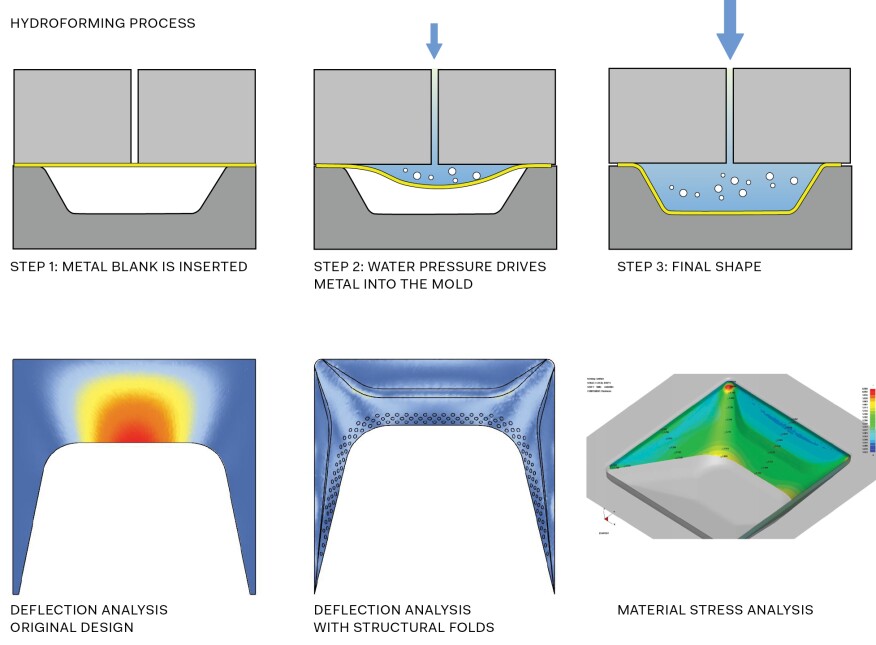Honorable Mention: Hydroformed Shading, a Metal Feature Shaped by Water
2018 R+D AWARDS
Honorable Mention: Hydroformed Shading, a Metal Feature Shaped by Water
For Harvard University’s Paulson School of Engineering and Applied Sciences, Behnisch Architekten created a system that would minimize the building’s energy load and maximize visual interest.

“There’s a sense of care and thought in terms of balancing the shade’s cost and production with its aesthetics, architectural value, and environmental value.” —Juror Tom Chung, AIA
In designing a six-story, 497,000-square-foot science and engineering complex for Harvard University, Behnisch Architekten faced two daunting tasks: how to minimize the energy load of the massive building, conceived as a series of large glass boxes; and how to minimize the enormous structure’s scale in Allston, a low-slung, academic and residential neighborhood across the Charles River from the university’s main campus in Cambridge, Mass. “We had a scaleless façade cladding, and we wanted to mask all that with a textured façade,” says Boston-based Behnisch partner Robert Noblett, AIA.
The solution was the development of a shading system that could pull double duty as a cooling mechanism and as a visual break in the building mass—and be lightweight enough to be installed on the façade with minimal structural support.
Inspired by the shapes, strength, and thinness of everyday objects like tin cans and soup bowls, Behnisch worked with German fabricator Edelstahl-Mechanik to create the world’s first hydroformed tensile façade. Common in the aerospace industry, hydroforming uses water pressure to shape ultrathin metal plates against a mold, creating custom pieces.



At one point, Behnisch considered using the same metal piece across the façade, but making it adjustable. However, Noblett says, that would require a motorized system, which would drain energy and introduce potential maintenance issues.
Instead, Behnisch stipulated 14 different shapes, varying in size and the number of facets, to maximize heat and light reflection at different points across the building façade. Just 1.5mm thick and weighing 10 pounds each, the 12,000 hydroformed plates are also perforated around the edges to allow in diffused light while minimizing heat intake. Despite their thin profile, the panels are strong enough to be connected directly to spring-tensioned steel cables attached to the building at the spandrels, which have auxiliary wind bracing.
The result, Noblett says, is a shading solution “as flexible and responsive as a motorized system, but fixed in place.” The system reduces the building’s peak cooling load by 65 percent, reflects natural light deep into the interior, and visually breaks up the building mass.






Project Credits
Project: Hydroformed Shading
Client: Harvard University
Design Firm: Behnisch Architekten, Boston
Collaborators: Knippers Helbig, Josef Gartner, Edelstahl-Mechanik
Façade Consultant: Knippers Helbig
Façade Contractor: Josef Gartner
Fabricator: Edelstahl-Mechanik
Structural Engineer: BuroHappold Engineering
M/E/P Engineer: van Zelm Heywood & Shadford
Civil Engineer: Nitsch Engineering
Geotechnical Engineer: BuroHappold Engineering
Climate Engineering: Transsolar
Construction Manager: Turner Construction Co.
General Contractor: Turner Construction Co.
Landscape Architect: Stephen Stimson Associates Landscape Architects
Lighting Designers: Bartenbach, Lam Partners
Interior Designer: Behnisch Architekten
Note: The project credits have been updated since first publication to correct the location of the Behnisch Architekten office that led this project.







0 Comments
Trackbacks/Pingbacks